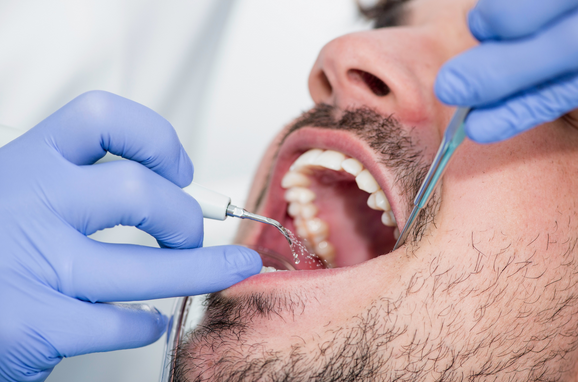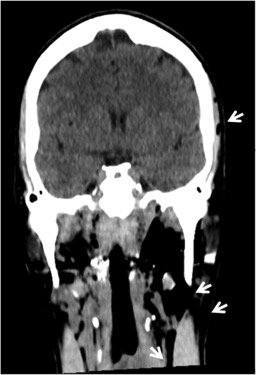- Silvia Paiardi
- Brief Report and Case Report
Cervicofacial emphysema after a dental hygiene procedure: a case report
- 3/2018-Ottobre
- ISSN 2532-1285
- https://doi.org/10.23832/ITJEM.2018.029
-
Emergency Department, Humanitas Research Hospital, Rozzano (Milano), Italy
-
Cardiovascular Department, Humanitas Research Hospital, Rozzano (Milano), Italy
-
Emergency Department, Humanitas Research Hospital, Rozzano (Milano), Italy

Abstract
Keywords
Introduction
Subcutaneous emphysema is the penetration of gasses into the subcutaneous tissues, leading to a swelling of the affected area. Causes include injury, head and neck surgery, mechanical ventilation, and invasive procedures. A few cases have developed during dental procedures, principally third molar extraction [1] [2], and due to increased mouth air pressure while playing a wind instrument [3] or blowing up a balloon [4]. Emphysema developing after dental procedures is usually limited to the head and neck, with only a few cases involving the mediastinum [5] [6].
We present a rare case of subcutaneous emphysema extending from the left scalp to the neck, following a maxillary dental hygiene procedure.
Case Report
Discussion
Conclusions
Our case is unusual in terms of the extent of emphysema noted and the simple dental procedure that triggered the problem. We present this case to emphasize the need of a rapid recognition of this condition in the ED, even if the patient has undergone simple endodontic procedure, in order to plan an appropriate management and to avoid rare but serious complications.
Figure 1 Coronal CT image depicting extensive emphysema (arrows) of both superficial and deep subcutaneous soft tissues of the left temporal region, extending from the masticatory, parapharyngeal and laterocervical spaces until the retropharyngeal space at the height of oropharynx.
Acknowledgements
Abbreviations
References
-
Yang, T. Chiu, T. Lin, and H. Chan, Subcutaneous emphysema and pneumomediastinum secondary to dental extraction: a case report and literature review,” The Kaohsiung Journal of Medical Sciences, vol. 22, no. 12, pp. 641–645, 2006.
-
S. McKenzie and M. Rosenberg, “Iatrogenic subcutaneous emphysema of dental and surgical origin: a literature review,” Journal of Oral and Maxillofacial Surgery, vol. 67, no. 6, pp. 1265–1268, 2009.
-
Turnbull, “A remarkable coincidence in dental surgery,” British Medical Journal, vol. 1, no. 2053, p. 1131, 1900.
-
G. Maxwell, K. M. Thompson, and M. S. Hedges, “Airway compromise after dental extraction,” Journal of Emergency Medicine, vol. 41, no. 2, pp. e39–e41, 2011.
-
Arai, T. Aoki, H. Yamazaki, Y. Ota, and A. Kaneko, “Pneumomediastinum and subcutaneous emphysema after dental extraction detected incidentally by regular medical checkup: a case report,” Oral Surgery, Oral Medicine, Oral Pathology, Oral Radiology and Endodontology, vol. 107, no. 4, pp. e33–e38, 2009.
-
Bocchialini G., Ambrosi S., Castellani A., Massive Cervicothoracic Subcutaneous Emphysema and Pneumomediastinum Developing during a Dental Hygiene Procedure, Case Reports in Dentistry Volume 2017, Article ID 7016467, https://doi.org/10.1155/2017/7016467
-
N. Heyman and I. Babayof, “Emphysematous complications in dentistry, 1960–1993: an illustrative case and review of the literature,” Quintessence International, vol. 26, no. 8, pp. 535–543, 1995
-
A. Van Tubergen, D. Tindle, G.M. Fox, Sudden Onset of Subcutaneous Air Emphysema After the Application of Air to a Maxillary Premolar Located in a Nonsurgical Field, Operative Dentistry, 2017, 42-5, E134-E138
-
Alonso, et al. Subcutaneous emphysema related to air-powder tooth polishing: a report of three cases, Australian Dental Journal 2017; 62: 510–515
-
Tenore, et al. Subcutaneous emphysema during root canal therapy: endodontic accident by sodium hypoclorite, Annali di Stomatologia 2017;VIII(3):117-122
-
J. Boggess, J. Ronan, N. Panchal, Orbital, Mediastinal and Cervicofacial Subcutaneous Emphysema after Dental Rehabilitation in a Pediatric Patient, Pediatr Dent 2017;39(7):465-7
-
A. Aslaner, G. N. Kasap, C. Demir, M. Akkas¸, and N. M. Aksu, “Occurrence of pneumomediastinum due to dental procedures,” American Journal of Emergency Medicine, vol. 33, no. 1, pp. 125.e1–125.e3, 2015
-
C. Karras and J. J. Sexton, Cervicofacial and mediastinal emphysema as the result of a dental procedure,” Journal of Emergency Medicine, vol. 14, no. 1, pp. 9–13, 1996.
-
B. Aragon, M. Franklin Dolwick, and S. Buckley, “Pneumomediastinumand subcutaneous cervical emphysema during third molar extraction under general anesthesia,” Journal ofOral and Maxillofacial Surgery, vol. 44, no. 2, pp. 141–144, 1986.


